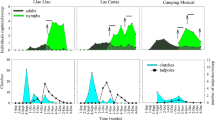We examined the seasonal dietary patterns of the endangered giant water bug, Lethocerus deyrollei, in rice fields located at Sayo, Hyogo Prefecture, central Japan. The results showed that L. deyrollei underwent a shift in its major food item from breeding adults of Hyla japonica in spring (May and June) to newly metamorphosed juveniles of Rana nigromaculata in summer (July to September). Dietary shifts were shown to correspond with a seasonal fluctuation in the availability of anurans in the rice fields. Although adults of R. nigromaculata were relatively abundant throughout the active season they were infrequently exploited by L. deyrollei, possibly because of the difficulty in handling these large-sized frogs. Therefore, seasonal partitioning of the rice-field habitat by small-sized frogs, adult H. japonica and juvenile R. nigromaculata, would enable L. deyrollei to forage in the rice fields during the extensive active period. From these results, we suggest that the conservation of frog populations is very important for the preservation of this endangered insect and for the maintenance of biodiversity within these rice-field ecosystems.
Similar content being viewed by others
REFERENCES
Cullen M. J. (1969) The biology of giant water bugs (Hemiptera: Belostomatidae) in Trinidad. Proceedings of the Royal Entomological Society of London (A) 44: 123–137.
Dimmock G. (1886) Belostomatidae and other fish destroying bugs. Zoologist 11: 101–105.
Fujioka M. & Lane S. J. (1997) The impact of changing irrigation practices in rice fields on frog populations of the Kanto Plain, central Japan. Ecological Research 12: 101–112.
Fukada H. (1992) Snake Life History in Kyoto. Impact Shuppankai, Tokyo.
Hasegawa M. (1995) Rana japonica in valley-bottom paddy fields in the Kanto Plain, Japan. In: Natural History in the Southern Kanto Plain (eds M. Osawa & T. Ohara) pp. 105–112. Asakura-shoten, Tokyo (in Japanese).
Hasegawa M. (1998) Recent change in anuran community adapted to traditional rice cultivation. In: Conservation of Biological Communities in Rivers, Ponds and Paddy Fields (eds Y. Ezaki & T. Tanaka) pp. 53–66. Asakura-shoten, Tokyo (in Japanese).
Hashizume H. (1994) All About the Giant Water Bug–Wishes for Symbiosis with Aquatic Animals (ed. Y. Miyatake). Tombo Publishing Co, Osaka (in Japanese).
Hidaka K. (1998) Biodiveristy conservation and environmentally regenerated farming system in rice paddy fields. Japanese Journal of Ecology 48: 167–178 (in Japanese).
Hoffman W. E. (1924) Biological notes on Lethocerus americanus (Leidy). Phyche 31: 175–183.
Hungerford H. (1919) The biology and zoology of aquatic and semi-aquatic Hemiptera. Kansas University Science Bulletin 11: 1–341.
Ichikawa N. (1988) Male brooding behaviour of the giant water bug Lethocerus deyrollei Vuillefroy (Hemiptera: Belostomatidae). Journal of Ethology 6: 121–127.
Ichikawa N. (1989) Repeated copulations benefit of the female in Lethocerus deyrollei Vuillefroy (Hemiptera: Belostomatidae). Journal of Ethology 7: 113–117.
Ichikawa N. (1990) Egg mass destroying behaviour of the female giant water bug Lethocerus deyrollei Vuillefroy (Hemiptera: Belostomatidae). Journal of Ethology 8: 5–11.
Ichikawa N. (1991a) Egg mass destroying and guarding behaviour of the giant water bug, Lethocerus deyrollei Vuillefroy (Hemiptera: Belostomatidae). Journal of Ethology 9: 25–29.
Ichikawa N. (1991b) Additional benefit of egg mass destruction by the giant water bug Lethocerus deyrollei Vuillefroy (Hemiptera: Belostomatidae) females. Journal of Ethology 9: 34–36.
Ichikawa N. (1993) Biased operational sex ratio causes the female giant water bug Lethocerus deyrollei to destroy egg masses. Journal of Ethology 11: 151–152.
Ichikawa N. (1995) Male counterstrategy against infanticide of the female giant water bug Lethocerus deyrollei (Hemiptera: Belostomatidae). Journal of Insect Behavior 11: 151–152.
Japan Environment Agency (2000) Threatened Wildlife of Japan – Red Data Book, 2nd edn. Japan Wildlife Research Center, Tokyo (in Japanese with English abstract).
Lane S. J. & Fujioka M. (1998) The impact of changes in irrigation practices on the distribution of foraging egrets and herons (Ardeidae) in the rice fields of central Japan. Biological Conservation 83: 221–230.
Tawfic M. F. S. (1969) The life-history of the giant water-bug, Lethocerus niloticus Steal. Bulletin de la Societe Entomologique d’Egypte 53: 299–310.
Tomokuni M. (1996) The Encyclopedia of Animals in Japan, Volume 8: Insect I (eds M. Ishii, T. Ohtani & Y. Johki). Heibonsha Limited Publishers, Tokyo.
Author information
Authors and Affiliations
Corresponding author
About this article
Cite this article
Hirai, T., Hidaka, K. Anuran-dependent predation by the giant water bug, Lethocerus deyrollei (Hemiptera: Belostomatidae), in rice fields of Japan. Ecol Res 17, 655–661 (2002). https://doi.org/10.1046/j.1440-1703.2002.00523.x
Received:
Accepted:
Issue Date:
DOI: https://doi.org/10.1046/j.1440-1703.2002.00523.x




